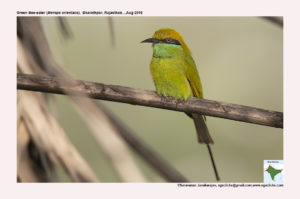
Green Bee-eater Merops orientalis
Etymology:
- Merops : Greek word for Bee-eater
- Orientalis: From Oriental zone , East
Vernacular Names: Sind: Nando traklo, Atedan, Hindi: Harial Patringa, Pun: Chhota patranga, Ben: Banspati, Ass: Harial sorai, Guj: Nano patrangiyo, Kutch: Chhota hajamda, Mar: Tai lingi, Veda raghu, Patur, Pateri, Ta: Kattalan kuruvi, Panchankam, Te: Chinna passeriki, Mal: Veli tatha, Kan: Sanna patanga, Gunguru paneha kalli peetha, Sinh: Kurumini kurulla
Distribution in India: Resident throughout India except the heights of Himalayas.
Description: Size of 16–18 cm. Streamers size of 8 cm; Wt. of 17·3–27 g. It is a small but long-tailed bee-eater, geographically highly variable. The nominate race is mostly bronzy green, with golden-green crown and hindneck, black band through eye, blue cheeks, pale bluish-green chin and throat, thin black gorget, black trailing edge on wing; underside of tail is shiny grey; tail-streamers are long; iris is crimson. The female is like male, but streamers are average shorter; has duller throat and narrower gorget. The juvenile is like adult, but pallid, lacks black gorget, body with barely discernible scalloped appearance, mask is dusky rather than black, breast is pale green, belly is almost white; gorget may be transitorily blue rather than black; occasional juveniles of all races have yellow or yellowish-green throat. The races vary greatly in colours of throat, crown and nape, width of gorget, and length and degree of attenuation of streamers: race beludschicus ( North West India) has golden-green crown and nape, pale blue chin becoming pale green on lower throat, gorget a very narrow line, streamers up to 6 cm; race ferrugeiceps ( North East India) shows rufous crown, nape and mantle, mask often narrowly bordered with green line above and pale blue below, green throat, streamers up to 6·3 cm.
Habitat: It is found in arid woodland with scattered trees on mainly bare soil or sand, and woodland with grassy undercover; also date-palm groves, wadis, thickets and thorn hedges around crops, lake sides, overgrazed pasture with thickets of Salvadora or Lantana, plantations, spacious gardens, dunes and farmland. It occurs from sea-level up to 2000 m.
Food Habits: They predominantly eat insects, especially bees, wasps and ants, which are caught in the air by sorties from an open perch. Before swallowing prey, a bee-eater removes stings and breaks the exoskeleton of the prey by repeatedly thrashing it on the perch
Breeding Habits: The breeding season is from March to June. They are often solitary nesters, making a tunnel in a sandy bank. The breeding pairs are often joined by helpers. The nest tunnel that they construct can run as much as 5 feet long and the 3-5 eggs are laid on the bare ground in the cavity at the end of the tunnel. The eggs are very spherical and glossy white. Clutch size depends on rainfall and insect food density. Both sexes incubate. The eggs hatch asynchronously with an incubation period of about 14 days and the chicks fledge in 3 to 4 weeks.